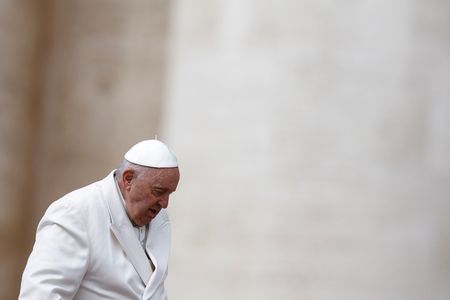By Crispian Balmer
VATICAN CITY (Reuters) – While the Vatican has looked to play down worries over Pope Francis’ health, his sudden hospitalisation has highlighted the 86-year-old pontiff’s increasing frailty.
On Wednesday, the pope had appeared in good form at his regular, weekly audience, joking with bishops, hugging a young girl and letting a group of children ride with him in his open-top popemobile.
But after returning to his Vatican residence he complained he was having difficulty breathing and his team decided he should be whisked to hospital for a series of medical tests.
These showed he was suffering a “respiratory infection”, the Vatican said in a statement, adding that he would stay in Rome’s Gemelli hospital for “several days” of “appropriate treatment”.
There was no sign of particular alarm from his staff and on Thursday the Vatican released a second statement to say that his “clinical picture is gradually improving”. It added that he had resumed working from his hospital suite.
There have always been question marks over the health of the pope – who was 76 when he was elected pontiff in March 2013 – because it was widely known that when he was in his 20s he had part of one of his lungs removed in his native Argentina.
He himself predicted early on that his papacy would be shortlived. “This will last a short time, two or three years, and then we go to the house of the father,” he told reporters in 2014, before making a chopping gesture and a whistling sound.
At the time, he had a spritely step and a slimmer girth.
These days he uses a cane and a wheelchair because of a persistent knee ailment, and his waistline has noticeably increased due to a more sedentary lifestyle in the Vatican that began even before his leg problem.
SURGERY
But the leader of the world’s nearly 1.4 billion Roman Catholics has dismissed suggestions he is ready to follow the example of his predecessor Benedict XVI and retire.
“You don’t run the Church with a knee but with a head,” he reportedly told an aide after he began sometimes using a wheelchair in public for the first time on May 5, 2022.
This week’s hospitalisation comes less than two years after the pontiff’s last stay at the Gemelli hospital’s papal suite, which is reserved exclusively for popes and contains a private chapel.
On that occasion, he had part of his colon removed, a procedure aimed at addressing a painful bowel condition called diverticulitis.
Two months ago, he said the condition had returned and that it was causing him to put on weight, but that he was not overly concerned. He did not elaborate.
In an interview with Reuters last July, Francis said he preferred not to have an operation on his knee because he did not want a repeat of long-term negative side effects from anaesthesia he suffered from the colon operation.
He also dismissed as “court gossip” rumours that cancer had been found during the 2021 surgery.
Last July, returning from a trip to Canada, Francis acknowledged that his advancing age and his difficulty walking might have ushered in a new, slower phase of his papacy.
But effectively he has not slowed down. After Canada, he went to Kazakhstan in September, Bahrain in November and made a gruelling trip last month to Democratic Republic of Congo and South Sudan.
He is already committed to visiting Hungary next month, Portugal in August and the French city of Marseille in September. He has said if it can be arranged, he would want to then fly from France to Mongolia.
Cardinal Kevin Farrell, a senior Vatican official, has called the pope a great example to elderly people facing mobility issues.
“He accepts his limitations at this moment with a great spirit and a great heart. I think he is an example to all of us. We should not hide the fact that with age comes a lessening of our ability to play an active part in the life of the world today,” Farrell told reporters last year.
(Writing by Philip Pullella and Crispian Balmer; Editing by Frances Kerry)





